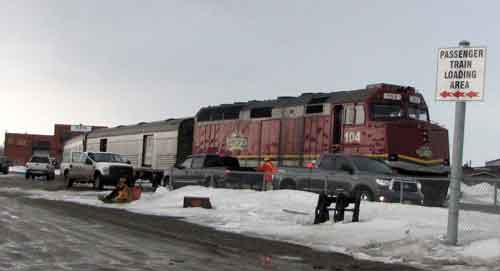From the Sault Star:

The ACR passenger service generates at least $38 million in total economic activity, a draft report by BDO Canada concludes.
In fact, the economic impact of the passenger train service between Sault Ste. Marie and Hearst, when including direct, indirect and induced economic impact ranges from $38,136,000 to $48,072,000, stakeholders were told at a meeting at the Civic Centre Thursday.
“This is a significant impact that may not be recognized by those who make the decisions,” said city CAO and chair of the working group Joe Fratesi.
The information from the draft report has already been provided to Transport Canada Minister Lisa Raiit.
Raiit was in Sault Ste. Marie Monday to announce that the federal government will provide a one-year extension to the $2.2 million subsidy it provides to CN to operate the service in order to allow stakeholders time to come up with a long-term solution to save the service.
The BDO Canada study, led by Joe Melisek and Jacob Barton, shows that while the direct impact of the service is somewhat limited at about $2.76 million, the indirect economic impact ranges between $13 to $16.9 million.
The induced impact also has a significant effect ranging between $22.2 to $28 million.
In addition, the service generates 220 jobs and contributes to the delivery of more than $5 million in tax revenue to government coffers annually.
BDO also examined the property values in the rural area and the report shows that the rail line supports more than $60 million in property value and provides immeasurable social benefits to the various group of stakeholders, property owners, users, First Nations and communities.
Melisek said the study was somewhat unique because the ACR provided the hard operational figures and passenger numbers needed and an abundance of surveys from stakeholders compiled the rest of the information needed.
The Economic Development Corp. received almost 500 surveys in the short time frame they had to collect the data and Melisek said that provided very good, reliable data from the broad user base.
At issue is the low ridership that has travelled the passenger train.
In 2013, a low number of 5,166 passengers used the rail service as opposed to a high of 12,640 passengers in 2005, the report indicates.
The government investment in the ACR is equivalent to an average of $425.86 per passenger, based on 2013 ridership numbers, the report states.
However, the report also notes that the $2.2 million federal government financial investment is not unreasonable when compared to other rail line investments in 2011 including Tshiuetin Rail Transportation’s 217 km line ($8.2 million) and the Keewetin Railway Company’s 400 km line ($2 million).
In addition, the study examined the economic impact analysis of property values.
Lodge property values are estimated at $9.3 to $10.3 million and cottage property values at between $51.4 and $56.9 million, resulting in a total economic impact of between $60.8 and $67.2 million.
“This is not a subsidy but really an investment to provide something the market in general is not going to provide us,” Barton told a room full of stakeholders.
While the social impact is hard to quantify, the loss of the rain line will have extreme negative effects on tourism, isolated communities, First Nations, employment and road access.
“The stakeholder group has also indicated that they feel the loss of passenger rail service indicates a negative trend that may contribute to the eventual termination o the Agawa Canyon Tour Train as well as the ACR freight service due to perceived lack of commercial viability,” the report states.
The report concludes that the subsidy is worthwhile of taxpayer funds because the service is crucial to stakeholders, and essential service to provide access to remote areas and provides strong economic benefit.
Fratesi said now is the time for stakeholders to move to the next step and suggest or develop ways that could help the rail line generate more revenue, reduce operational costs, develop partnerships with public-private sector and market its product better to increase the user base.
Stakeholders will be given until the end of the month to provide their specific ideas to the working committee.
Ideas already presented on the floor included combining the ACR with lines to cross Canada, develop a more up-to-date and accurate website and other marketing tools and allow groups to more easily organize and plan specialty trips to encourage ridership.
The working group is confident that CN is receptive to developing a workable solution and in the future, should be included in the group to test various scenarios.
Source: http://www.saultstar.com/2014/04/17/acr-has-tremendous-economic-impact-study-concludes
